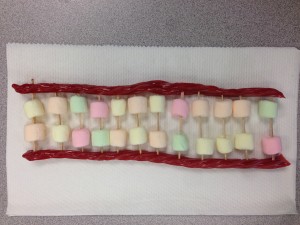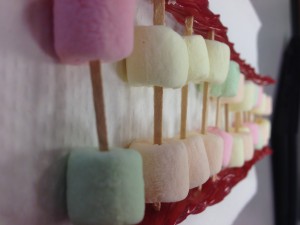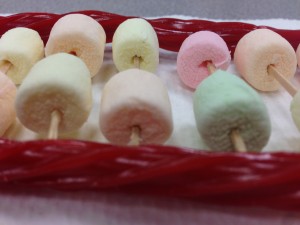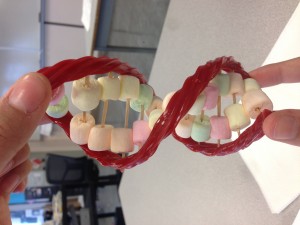Hunter Syndrome
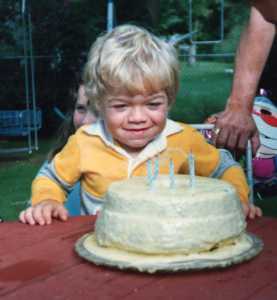
Young Christopher Dutcher, a boy with Hunter Syndrome
https://globalgenes.org/raredaily/christopher-dutcher-on-hold/
Photo may be used for non commercial use
Hey there! My name Genette and I am a gene. I’m a bit how you could say…abnormal. I’m not like other genes. I’m located on the X Chromosome of my host, also known as Gerard. Gerard has what’s known as “Hunter Syndrome.” I thought I’d tell you a bit about myself, and what really happens here in these cells. Because honestly, half the times all theses other hosts don’t know what’s really going on.
Hunter Syndrome was caused by what’s known as a mutation. Or me I guess…There are three types of mutation. Insertion, deletion, and substitution. I was caused by substitution. With Hunter Syndrome, how it’s caused can really vary. As a gene, I am part of a chromatin, which is coiled into a chromosome. The chromosome is also known as DNA. All humans have 46 chromosomes in pairs of 23. During the process of protein making, the DNA is copied into RNA which is transported out of the nuclear pore. Then a ribosome codes the RNA and turns it into a protein. After that, the process continues. Except, because I am an abnormal gene when the DNA is copied into RNA, the RNA is mutated as well and the process continues whenever I am copied. So unfortunately for Gerard, a lot of the proteins that make him up are mutated, causing Hunter Syndrome.
Life can get boring as a gene though. Day after day, just non-stop working. Here in this cell, there’s no Union so no worker’s rights. It’s completely exhausting. I have my side of the story too. It’s not always my fault that Gerard’s mutation occurred.
I was actually passed down from Gerard’s mother. I’m a gene that can be inherited, and mainly just to boys. She was the cause of Gerard’s mutation. She had an uncommon I2S (also known as IDS) gene and passed it down to him. She wasn’t affected because she has two X chromosomes, and it balanced out fine. Because Gerard only has one, it caused the mutation.
In some cases, boys can get me during the egg and sperm formulation. In these cases, I decide to be spontaneous and just to form on the X Chromosome of the sperm. In which the mom did not have any unusual chromosomes carrying me. So that way it’s a lot less likely that any of the child’s siblings would have Hunter Syndrome.
Boys only have one X chromosome and girls have two. Basically because of me, Gerard doesn’t have enough enzyme iduronate sulfatase. This is the enzyme that breaks down sugar molecules that are pretty complicated, and it ends up happening that all this sugar builds up in the blood, cells, and even tissue.
For Gerard, life has been different than your average 7-year-old boy. Gerard has large round cheeks, a thicker tongue which sometimes causes respiratory problems. Gerard’s forehead is quite a bit bigger and his lips are quite full. The list of medical problems that I’ve caused Gerard goes on and on. Thankfully he hasn’t had any heart problems yet, but the possibility of his heart valves becoming damaged is still there. Gerard still has trouble breathing sometimes because he only has 30% lung capacity. He’s had to have several operations already. The doctors are trying to fix me but it’s proving to be really difficult. Gerard’s bones are starting to get thicker and the doctors have to keep trying to decrease the size.
Gerard had trouble learning new things up between the ages of 2 and 4 years old. That’s when most of his symptoms started to occur. Sometimes Gerard can get easily frustrated or aggressive. He doesn’t mean any of it, it’s just harder for him to control it. Gerard really is a very lighthearted and soft-hearted kid.
It’s been hard for Gerard to make friends. His parents love him all the same and so does his older sister Carmen, but the other kids aren’t quite as friendly. It’s hard for Gerard to talk sometimes so communicating with other kids isn’t as easy for him. Because Hunter Syndrome only affects 1 in 170,000 people most of his classmates have never seen someone with his disability. Thankfully he hasn’t been bullied too much because he’s different, but making friends isn’t easy. Most of the kids already have their own friends.
It’s not always too bad though. Gerard does have one friend named Frankie. He always sticks up for Gerard in the small instances when a kid would pick on him.
Part 2: The Making of the Mutation Story
- Questions I used to found my research were questions such as:
-What are the genetic causes of Hunter’s Syndrome?
-What are the physical side effects?
-How does this mutation effect the child’s physical attributes?
-How is Hunter’s syndrome acquired?
-Where are these effects most visible?
-When does the mutation start to become noticeable?
- To research this project, I used the search engine and I also used YouTube. I did my research on various websites instead of just using one. I found new sites outside of the basic Wikipedia, such as medical analysis companies that are doing research on this disease. As for YouTube, I researched videos talking about this mutation until I found one that I was able to use.
- To make this project, first I asked my questions. I found out different pieces of information about Hunter’s Syndrome. My next step was to look up information through the internet, take notes and acquire the data. I used the notes to create my own sentences and formed the informational paragraphs. After that, I reviewed my information and made sure it all fitted together. That none of the facts overlapped each other and that it made sense. Lastly, I re-assessed my work, looking it over to see what I could improve. I had a friend read over my work and give me feedback.
- To verify my information, I visited the websites and verified that they had the correct information. I made sure they weren’t blogs where anyone could post information and that they were, in fact, actual websites. I looked at who had posted the information and made sure they were official domains ending in .org, .gov or .net instead of .com or.ca. Finally, I compared the websites against each other to make sure they don’t contradict each other. If there was one or two that had different information compared to the majority, I ruled them out considering they were the minority and most likely incorrect.
Here are the links to the websites I used.
http://www.ninds.nih.gov/disorders/mucopolysaccharidoses/detail_mucopolysaccharidoses.htm
https://en.wikipedia.org/wiki/Hunter_syndrome
https://www.nlm.nih.gov/medlineplus/ency/article/001203.htm
http://huntersyndrome.info/en-ca/?gclid=CjwKEAiAws20BRCs-P-ssLbSlg4SJABbVcDploCuUusy1CtR4gNCXgUKO4C-NfpjCNlDPF50n-y24hoCRCvw_wcB
http://www.mayoclinic.org/diseases-conditions/hunter-syndrome/symptoms-causes/dxc-20165662
http://www.news-medical.net/health/Hunter-Syndrome-Genetics.aspx
http://ghr.nlm.nih.gov/condition/mucopolysaccharidosis-type-ii
https://globalgenes.org/raredaily/christopher-dutcher-on-hold/
As for the picture I used, I did some research regarding how to know if a picture can be used from a website. Because the website I got the picture from did not have specific requirements if people used the photo, I had to look up the rules of photo sharing. From what I’ve gathered, if it is used in a non-commercial and educational way, it should be perfectly fine unless there is a copyright sign or other clear signs that the owner does not want you to use this picture at all.
I also found a YouTube video about Hunter Syndrome Unfortunately the comment section was disabled so I could not ask any further questions.
https://www.youtube.com/watch?v=QybEtuDsd9I
- I find that the process went fairly well. I think that I was able to use various steps to complete this task and find information. Once all the facts were acquired, it wasn’t too difficult to put them together in a story. In the future, I think I would have gone in depth with the story. To have done a better job, I might have tried to find more stories about people who have this mutation and how it affects their lives instead of just one story. I could have also gone more in-depth with the full process of how the gene appears by doing more extensive research.

![20160115_094904-1[1]](http://myriverside.sd43.bc.ca/alysony2015/files/2016/01/20160115_094904-11-27l37oq-300x242.jpg)

